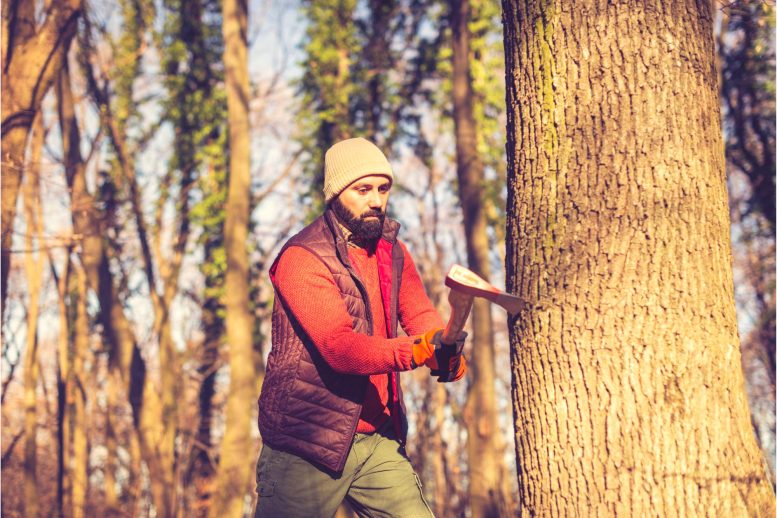
A new study highlights the complex relationship between oaks and the environment. As the Earth warms, plants like oaks emit more isoprene, a compound that can degrade air quality. Yet, this same compound also benefits clean air and enhances plant resilience. While some suggest planting fewer such trees, the researchers believe a better approach would be controlling nitrogen oxide pollution.
It’s a simple question that sounds a little like a modest proposal.
“Should we cut down all the oak trees?” asked Tom Sharkey, a University Distinguished Professor in the Plant Resilience Institute at Michigan State University.
Sharkey also works at the MSU Department of Energy Plant Research Laboratory and in the Department of Biochemistry and Molecular Biology.
To be clear, Sharkey wasn’t sincerely suggesting that we should cut down all the oaks. Still, his question was an earnest one, prompted by his team’s latest research, which was recently published in the scientific journal Proceedings of the National Academy of Sciences.
The team discovered that, on a warming planet, plants like oaks and poplars will emit more of a compound that exacerbates poor air quality, contributing to problematic particulate matter and low-atmosphere ozone.
The rub is that the same compound, called isoprene, can also improve the quality of clean air while making plants more resistant to stressors including insects and high temperatures.
“Do we want plants to make more isoprene so they’re more resilient, or do we want them making less so it’s not making air pollution worse? What’s the right balance?” Sharkey asked. “Those are really the fundamental questions driving this work. The more we understand, the more effectively we can answer them.”
Spotlight on isoprene
Sharkey has been studying isoprene and how plants produce it since the 1970s when he was a doctoral student at Michigan State.
Isoprene from plants is the second-highest emitted hydrocarbon on Earth, only behind methane emissions from human activity. Yet most people have never heard of it, Sharkey said.
“It’s been behind the scenes for a long time, but it’s incredibly important,” Sharkey said.
It gained a little notoriety in the 1980s when then-president Ronald Reagan falsely claimed trees were producing more air pollution than automobiles. Yet there was a kernel of truth in that assertion.
Isoprene interacts with nitrogen oxide compounds found in air pollution produced by coal-fired power plants and internal combustion engines in vehicles. These reactions create ozone, aerosols, and other byproducts that are unhealthy for both humans and plants.
“There’s this interesting phenomenon where you have air moving across a city landscape, picking up nitrogen oxides, then moving over a forest to give you this toxic brew,” Sharkey said. “The air quality downwind of a city is often worse than the air quality in the city itself.”
Now, with support from the National Science Foundation, Sharkey and his team are working to better understand the biomolecular processes plants use to make isoprene. The researchers are particularly interested in how those processes are affected by the environment, especially in the face of climate change.
Prior to the team’s new publication, researchers understood that certain plants produce isoprene as they carry out photosynthesis. They also knew the changes that the planet was facing were having competing effects on isoprene production.
That is, increasing carbon dioxide in the atmosphere drives the rate down while increasing temperatures accelerate the rate. One of the questions behind the MSU team’s new publication was essentially which one of these effects will win out.
“We were looking for a regulation point in the isoprene’s biosynthesis pathway under high carbon dioxide,” said Abira Sahu, the lead author of the new report and a postdoctoral research associate in Sharkey’s research group.
“Scientists have been trying to find this for a long time,” Sahu said. “And, finally, we have the answer.”
“For the biologists out there, the crux of the paper is that we identified the specific reaction slowed by carbon dioxide, CO2,” Sharkey said.
“With that, we can say the temperature effect trumps the CO2 effect,” he said. “By the time you’re at 95 degrees Fahrenheit — 35 degrees Celsius — there’s basically no CO2 suppression. Isoprene is pouring out like crazy.”
In their experiments, which used poplar plants, the team also found that when a leaf experienced warming of 10 degrees Celsius, its isoprene emission increased more than tenfold, Sahu said.
“Working with Tom, you realize plants really do emit a lot of isoprene,” said Mohammad Mostofa, an assistant professor who works in Sharkey’s lab and was another author of the new report.
The discovery will help researchers better anticipate how much isoprene plants will emit in the future and better prepare for the impacts of that. But the researchers also hope it can help inform the choices people and communities make in the meantime.
“We could be doing a better job,” Mostofa said.
At a place like MSU, which is home to more than 20,000 trees, that could mean planting fewer oaks in the future to limit isoprene emissions.
As for what we do about the trees already emitting isoprene, Sharkey does have an idea that doesn’t involve cutting them down.
“My suggestion is that we should do a better job controlling nitrogen oxide pollution,” Sharkey said.
Reference: “Hydroxymethylbutenyl diphosphate accumulation reveals MEP pathway regulation for high CO2-induced suppression of isoprene emission” by Abira Sahu, Mohammad Golam Mostofa, Sarathi M. Weraduwage and Thomas D. Sharkey, 2 October 2023, Proceedings of the National Academy of Sciences.
DOI: 10.1073/pnas.2309536120
Sarathi Weraduwage, a former postdoctoral researcher in Sharkey’s lab who is now an assistant professor at Bishop’s University in Quebec, also contributed to the research.









Oak trees can host up to 300 species, being one of the most productive hubs for biodiversity in our landscapes (Tallamy). This exists in a silo that doesn’t account for the mass extinction crisis were already facing.
Thank you for the “Tallamy” comment on Oaks being a keystone plant to help slow down what is known as “the Sixth Mass Extinction” of biodiversity in our ecosystems. This points to the complexity of the work on climate change mitigation and adaption. We cannot work on silos without checking on other areas of work. We probably need to establish a unit that oversees different efforts in order to look for these intersections of dissonance. What do you say SciTech? Can you look at this through your reporting or know of such an entity?
“… the team also found that when a leaf experienced warming of 10 degrees Celsius, its isoprene emission increased more than tenfold, …”
It should be obvious that it can’t sustain that level indefinitely. How much does the isoprene emission increase for a 20 deg C increase? 30 deg C? How long does the pulse last? Does the same thing happen on the second and third day of a heat wave, or are the pulses smaller? Is the emission the same for all 300 species of oak? Does anything other than temperature control the emissions, such as the photosynthesis activity controlled by the season?
So many questions, so few answers.
Squirrels unite! Save our oaks!
I feel as if the real problem is the nitrous oxide pollution. Would decreasing NO emissions not eliminate the problem with isoprene without removing the benefits?
On the other hand isoprene could polymerize into a plastic, producing plastic snowflakes in the middle of summer.
Stringent human birth control would help more. So would fewer articles like this.
“To be clear” is in the small print. SHOULD WE CUT DOWN ALL THE OAKS is what 90% of your readers will notice.
Oaks sequester Carbon Dioxide as well as (best, some say) any other plants. They sustain (shelter, feed, prevent erosion, etc.) better than any other genus.
Like a newspaper that flashes dramatic headlines to (irresponsibly) gain readership (AKA $), then explains nuances, even compelling arguments against their headline’s assertion, you’ve provided a disservice to the environment and those working to mitigate the Climate Crisis.
Oak trees are sacred to Thor.
A lot of these so called scientists are sick people.
When are we going to finish pushing this unnatural ridiculous pseudo-science just to fit with the global warming agenda? Criminals
The original title was “Hydroxymethylbutenyl diphosphate accumulation reveals MEP pathway regulation for high CO2-induced suppression of isoprene emission”.
So now trees which have been here millions of years before us are now polluting earth …….. unbelievable !!
Have we taken leave of our sense.
The problem is the common habit, of those with a political agenda, to use words that have acquired an association with a subjective evaluation, to manipulate the feelings of the reader. Examples are “ocean acidification” versus pH reduction, or “ocean boiling” instead of listing the small increase in measured temperature as actually measured. It is political activists who call themselves ‘scientists’ that are most guilty of this.
This rag of a publication is a joke. Nice clickbait headline you have there. The most amazing thing the WEF has done is to convince people that a gas that we exhale is bad for the environment. They have done this by paying researchers the write bogus papers.
Pollution? Isn’t it ironic that NASA satellites are showing that the Earth is turning greener as a result of the CO2 being added and the slightly warmer temperatures.
Absolutely Absurd- the earth is just going through natural cycles like it always has – mankind can not destroy the earth! Fear mongering is all this garbage is – until the last 7PLAGUES and God really punishes the wicked with heat – there is no such thing as climate change other than natural weather conditions.
Revelation 16
Enjoy what is about to happen to the world when they bow down to forced Sunday worship. Revelation 13
Revelation 14:6-13 & 18 is Gods last call to come out of Sunday worship or recieve her plagues REVELATION 16
So now the cult of Global warming wants to cut down all the trees….so apparently carbon dioxide isn’t going to kill us now .
Seems like a good feed back loop. Bad air and heat makes trees produce chemicals that help other photosynthesizing carbon sinks thrive?
Plant more 🤣
Leave the oaks and all other trees alone. Instead, let’s start takinmg down scientists with a God complex who arrogantly consider they know more than the creator about how to keep our planet balanced and healthy.
Haven’t they done enough damage already?
The reading comprehension in these comments is appalling. Even if you only read the first and last line. You would understand that no one is actually suggesting cutting down trees.
“My suggestion is that we should do a better job controlling nitrogen oxide pollution,” Sharkey said.
The issue, as usual, is that we are polluting the planet and it is having unforeseen consequences. The solution is still to stop polluting the planet.
Ahhh, the poster child for Junk Science.
While the headline is eye grabbing, the research is not. Sorry PhD students out there. You may be doing great science, but let’s not inflate the significance beyond that it serves a purpose (get’s you a degree and expands knowledge).
It is well known that terpene compounds are the source of the “smoke” in the Great Smoky Mountains of the US and those come from the trees there. But now I learned that isoprene is the building block for the terpenes and the conifers emit a bunch of these in this region. If the deciduous (oaks and poplars) emit isoprene, the conifers must produce it as well.
The Great Smoky Mountains were smokey before man and will stay that way as long as they are there. Let’s keep our trees, let them grow and be harvested sensibly or protected where appropriate. They are a gift and we need to use our gifts wisely.